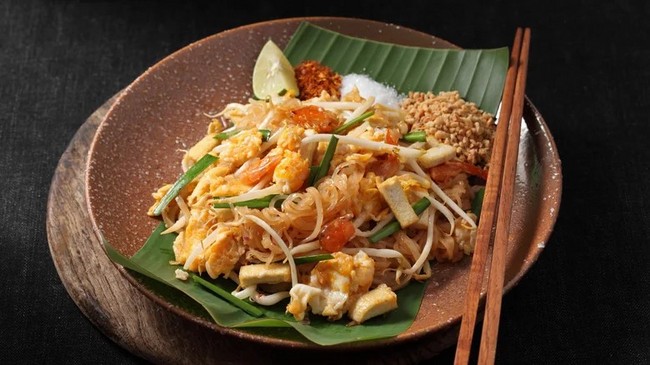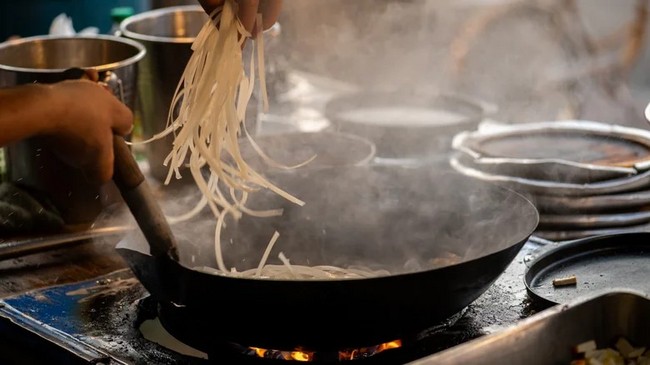✕



✕

Tag:pad thai facts 2025-01-09 16:00

seksan wangjaisuk/Shutterstock
Celebrated for its balance of sweet, sour, salty, and spicy elements, Thai cuisine has become a worldwide favorite, and pad Thai (which translates to "Thai-style stir-fried noodles") stands out as a beloved food in Thailand and internationally — so much so, it was ranked among the to p 10 most-ordered dishes globally by Uber Eats in 2022. Pad Thai's recipe combines rice noodles with ingredients like eggs, tofu, bean sprouts, and a tangy-sweet sauce made from tamarind, fish sauce, and palm sugar. The dish is typically garnished with crushed peanuts and lime wedges.
Despite being an emblem of Thai cuisine, pad Thai is a cultural fusion of Thai flavors and Chinese culinary influences. Rice noodles cooked in soup or stir-fried came to Thailand with an influx of Chinese immigrants over the last two centuries. However, pad Thai essentially originated as a form of governmental propaganda. Its roots date back to World War II. In 1938, Thailand experienced a rice shortage due to military action and a flood that damaged the country's crops.
Prime Minister Plaek Phibunsongkhram, who seized power from the monarchy in 1932, sought to modernize the nation and foster a strong sense of Thai identity with efforts such as changing the country's name from "Siam" to "Thailand." He introduced a national dish made of noodles and promoted a "noodle is your lunch" government campaign. The Thai government heavily encouraged people to eat noodles regularly, and by the end of the war, pad Thai was sold everywhere as a street food and in restaurants.
How gastrodiplomacy fostered the spread of pad Thai

worradirek/Shutterstock
Plaek Phibunsongkhram's promotion of stir-fried noodles as a symbol of Thai culture had a lasting impact. By encouraging the consumption of noodles, which required less rice, the government aimed to strengthen the economy, preserve Thailand's rice paddles, and provide food security. While many individuals credit Phibunsongkhram as the creator of pad Thai, other historians have revealed that documented recipes of pad Thai didn't actually emerge until the 1960s, indicating that the nation's close ties with the U.S. during the Vietnam War and the rise tourism in Thailand may have played a pivotal role in shaping the recipe as it is commonly known today.
Nevertheless, after World War II, Thailand's government actively used its cuisine as a form of cultural diplomacy, encouraging the establishment of Thai restaurants abroad to showcase the country's rich culinary traditions. At the same time, pad Thai resonated with Thai immigrants who brought their recipes and culture to the U.S. and other parts of the world. Thai restaurants blossomed, introducing pad Thai to American diners and quickly making it a favorite.
By the early 2000s, efforts like the Global Thai Program aimed to expand the presence of Thai cuisine worldwide to promote its international image and strengthen Thailand's foreign relations (which explains why Thai menus are so similar to one another). This initiative was successful, resulting in the abundance of Thai restaurants that surround us today.
dsm firmenich enters Chinese partnership to slash cattle farming emissions
UK at risk of cauliflower and broccoli shortage due to extreme weather conditions
Grupo Bimbo mitigates risk of cyber attacks with NanoLock Security partnership
Dutch government backs cellular agriculture advancements with financing for R&D hubs
About Us Terms of Service Privacy Policy Contact Us
Hotline(+86)17301604571
 Enterprise WeChat
Enterprise WeChat
for Client Service
 EZBuy
EZBuy
WeChat APP
Sinoexpo Digital Platform
Shanghai Sinoexpo Informa Markets International Exhibition Co., Ltd. All rights reserved
沪ICP备05034851号-77
 沪公网安备31010402000543号
沪公网安备31010402000543号